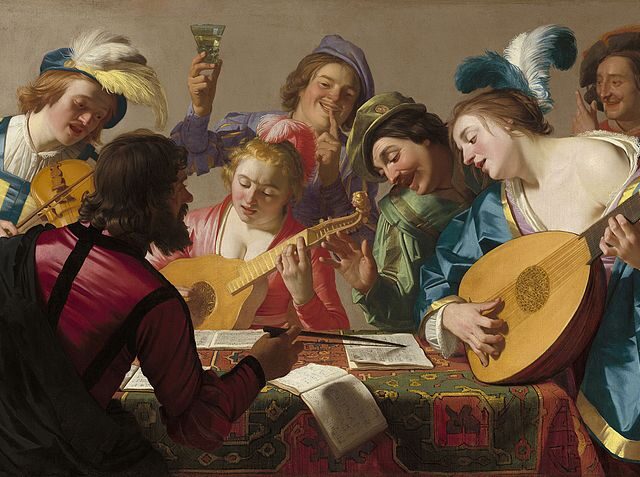Have you ever heard someone refer to a sandwich from their favorite deli as the “Stradivarius of hoagies”? In popular culture the name Stradivari has become a synonym for luxurious and exquisite, and has been applied to everything from Leontyne Price (the Stradivarius of singers) to a really great piece of chalk. But who is this Stradivari person, and is he worthy of his reputation?
In the late 1600s and early 1700s Antonio Stradivari was living in the city of Cremona, Italy, where he built stringed instruments (not sandwiches) primarily for the rich and powerful. The Cremonese instruments made by Stradivari and other talented Italian luthiers were so much higher quality than all previous instruments that they were valued as works of art and put on display. But some buyers wanted their instruments to be heard, even if they themselves were barely capable of scratching out a few shrill notes. Many of the lords and nobles who amassed collections decided to set up patronage relationships with musicians who would borrow their prized instruments and perform concerts for the owner’s friends and family.
This relationship between collectors and musicians has extended to the present day, except hedge-fund managers and technology entrepreneurs have replaced the lords and nobles of 17th-century Europe. (You would be forgiven for thinking that Mark Zuckerberg and Jeff Bezos are actual lords in their companies’ self-sufficient campus fiefdoms.)
David Fulton is perhaps the best-known modern music patron, although he never planned it that way. Fulton started out as a violinist and became concertmaster for the University of Chicago in the 1960s where he developed an obsession with antique violins. Even after he shifted focus to a career in computer science and mathematics, Fulton took out a loan worth more than his house to buy his first Italian instrument, a 1698 Pietro Guarneri. Eventually he founded and then sold a database management company to Microsoft, which hired him as vice president of one of its divisions. In 1994 Fulton retired and decided not to cash out the stock he had earned. A few years later Microsoft’s value skyrocketed, and Fulton had enough money to pay back his loans and buy whatever he wanted.
And Fulton wanted Cremonese instruments. Lots of them. Fulton’s collection at its height consisted of at least 22 of the finest instruments in the world, including a number of Stradivariuses and Guarneris, which resided in a temperature-controlled, fireproof vault in his Seattle home. Over the years Fulton has loaned out many of his instruments for special performances and museum exhibitions, but his collection falls squarely in the middle of a much larger debate between people who believe instruments should be played and people who want to preserve instruments at all costs. Although Fulton has invited dozens of world-renowned violinists into his home to play alongside him with his collection, he has been cautious not to overuse his instruments, perhaps to the chagrin of those who haven’t been allowed to play them. Speaking to Amati magazine in 2014, Fulton defended his decision: “The fact is that violins are improved by playing to the same extent that wood floors are improved by being walked on.”
While working on an upcoming magazine article about what makes a Stradivarius special, I became curious about Fulton’s perspective. How hard is it to maintain a Cremonese instrument over time, and does playing an instrument also degrade it? To find out I decided to interview two professional musicians with my own favorite instrument, a digital voice recorder (made in China rather than Cremona). Those musicians, Laura Hamilton and Lanny Paykin, also happen to be my girlfriend’s parents.
After thoroughly disappointing Hamilton and Paykin with my lack of musical knowledge, I learned that even the best Cremonese instruments in the world have unique “personalities” that make them difficult to repair and play consistently. Hamilton’s instrument, while not quite a Stradivarius (it was made sometime before 1730 by Carlo Tononi in Venice), is similarly temperamental.
“Like this week,” she said. “I’m not happy with the way my violin is sounding right now, and it was good a month ago. It was in pretty good shape, but the weather changes, and I think maybe one of the seams is open.”
Hamilton goes to a handful of trusted violin shops when her instrument needs adjustment, but she often gets conflicting advice. Paykin agreed: If you go to one luthier, he or she might say, “ ‘Oh, your bass bar, terrible condition. You have to replace it.’ ” If you go to another one, you might hear, “ ‘Oh, your bass bar is fine. It’s just some cracks on the side.’ ” Anyone who has brought their car to different mechanics should be able to relate.
These anecdotes appeared to me to add up to one bitter truth: eventually all old Italian instruments will break down and fall apart or at least need major repairs. Fulton’s conservative approach of minimal use must have been correct.
But Paykin immediately disagreed and argued that the lives of the remaining Cremonese instruments that are well cared for are virtually indefinite.
When I asked the same question of Christopher Germain, a luthier based in Philadelphia who I also interviewed for my article, he said the same thing: “I believe as long as they’re properly maintained and restored and used with care, they can continue for as long as we’re willing to maintain them.”
Outside of accidents—such as when one of Germain’s customers backed over his cello with his car—no one seemed to think there was any reason a Stradivarius that has been played for 300 years would become unplayable in the next 300. Split seams and cracked sound posts are short-term problems. In the worst-case scenario entire sections of an instrument would have to be replaced.
A violin that has been repaired after being dropped, drowned, or crushed probably wouldn’t sound the same or even be considered the same instrument. But what about more insidious changes? A replaced peg here, a filled seam there, until eventually there is more new material than old. A thousand years before Stradivari made his first instrument, the Greek philosopher Plutarch posed a now-classic thought experiment that is especially relevant to this question: if you repair a ship over many years, and replace each plank one at a time as it decays until there is not a single original plank left, do you still have the same ship you started with?
Fulton would probably say no. However, in the early 2000s he had a slight change of heart. Realizing that his family cared little for his collection and would likely not know what to do with it after he was gone, he started selling off his instruments. (Fulton may have also been inspired by a sudden spike in Cremonese instrument value that made his sizable fortune even bigger, although he claims he never intended for his collection to be an investment.) Even after liquidating most of his instruments, he plans to hold onto his favorite quartet of two Strads and two Guarneris, which also happen to be four of the best-preserved, least-played Cremonese instruments in existence. Whether or not that quartet stays locked in a vault to preserve its value or is regularly played by worthy musicians remains to be seen.




